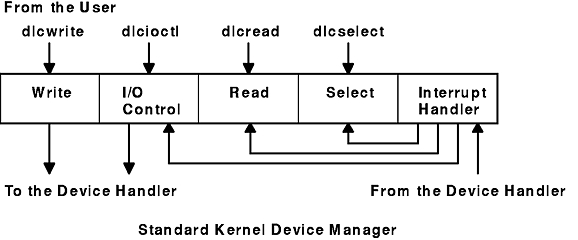
Each data link control (DLC) device manager operates in the kernel as a standard /dev entry of a multiplexed device manager for a specified protocol. For an adapter not in use by DLC, each open subroutine to a DLC device manager creates a kernel process. An open subroutine is also issued to the target adapter's device handler. If needed, issue additional open subroutines for multiple DLC adapter ports of the same protocol. Any open subroutine targeting the same port does not create additional kernel processes, but links the open subroutine with the existing process. Each active port always uses one kernel process.
The internal structure of a DLC device manager has the same basic structure as a kernel device handler, except that a kernel process replaces the interrupt handler in asynchronous events. The Read, Write, I/O Control, and Select blocks function as set forth in the Standard Kernel Device Manager figure.
Figure 1-3. Standard Kernel Device Manager. This diagram shows the dlcwrite, dlcioctl, dlcread, and dlcselect (from the user) traveling to write, I/O control, read and select, respectively (in the standard kernel device manager). The interrupt handler gets input from the device handler and its output is directed to select, read, and I/O control. The output of I/O control and write goes to the device handler.

Use the information in the following table to add an installed DLC.
Note: A data link control (DLC) must be installed before adding it to the system.
| Adding an Installed DLC Task | ||
|---|---|---|
| Web-based System Manager | wsm, then select network | |
| -OR- | ||
| Task | SMIT Fast Path | Command or File |
| Adding an Installed DLC | Choose one (depending on type):
| mkdev |
Note: The SMIT fast path to add an Ethernet device manager includes both Standard Ethernet and IEEE 802.3 Ethernet device managers.